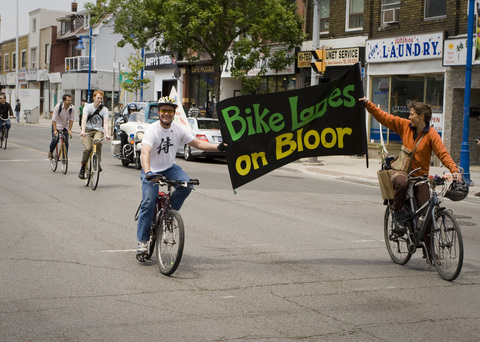Biking and walking in the city

(Credit: eric robinson via Flickr)
Most Ontarians live in cities and one of the ways to support good physical, mental and social health is to build healthy cities. How cities are organized affects individuals' ability to be active physically, economically, or socially. Making active transportation the safe and easy choice can also affect air quality and contribute to lowering the burden of illness associated with airborne pollution.
Increasing opportunities to be active in the city is important in building social connections and is essential to the continued growth of Toronto. Physical activity reduces the risk of over 25 chronic diseases including coronary heart disease, hypertension, breast cancer, colon cancer, Type 2 diabetes and osteoporosis. However, high-density traffic, air pollution and lack of cycling and pedestrian infrastructure make it difficult for people to stay active.
Torontonians have already benefited from more stringent emission and fuel economy standards. In 2007, air pollution from traffic was responsible for 440 premature deaths and 1,700 hospitalizations in Toronto. By 2014 these figures had each fallen by 36 per cent. These health benefits can be enhanced by investing in walkable and bikeable communities that allow more drivers to switch to active transportation.
Providing safe infrastructure for active transportation is a critical step in increasing physical activity and potentially improving air quality. Barriers to biking vary by community but some common ones are disconnected bike lanes and high-density traffic. A total of 55 per cent of trips taken within the city of Toronto are less than seven kilometres long. A safe, well-connected network of bike lanes and trails could go a long way to help increase the number of cyclists in our city.
Working towards meeting our larger environmental goals while simultaneously tackling the problem of inactivity benefits everyone. This can be supported by developing complete streets guidelines and implementing active city principles, to name but a few options.
Healthy cities that support everyone's health don't just happen. A high degree of engagement and participation is required to grow the kind of city we want to live in.
We all have a part to play in making biking and other active transportation options like walking, taking transit and rolling more accessible to everyone in cities across the country. Help create a positive reception for city-wide complete street guidelines and help make them a reality by talking about how you think they will make the city a better place. You can also share your opinions by attending public consultations and expressing why you think active living infrastructure (including biking) is important.
Above all else, the best way to support new infrastructure and decrease inactivity is for you to start biking and keep biking. It's worth it.
Hey! Want more DSF? Join David Suzuki on Facebook
David Suzuki's Blog
- David Suzuki's profile
- 247 followers



